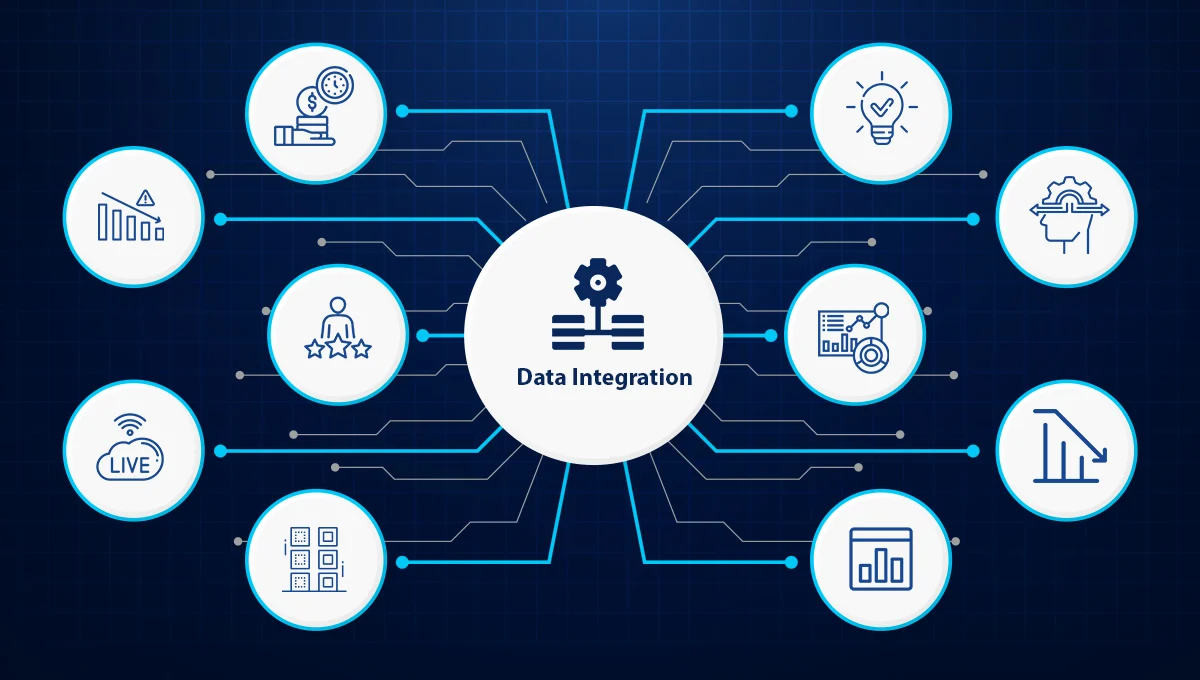In today’s data-driven world, data migration plays a crucial role in enabling businesses to adapt and thrive. Whether it’s moving data between storage devices, transferring data between databases, or shifting data related to specific business processes, a well-executed data migration strategy is essential for seamless transition and success.

What is Data Migration?
Simply put, data migration is the task of transferring bundles of data from one system or format to another. Naturally, this process involves extracting, modifying, and loading the data into a new destination. It can happen due to various reasons like upgrading systems or consolidating data.
Given the importance of data in big companies, careful planning and execution of this process are necessary to maintain the accuracy and reliability of the transferred data because the objective is to smoothly transition data to a new environment while ensuring continued access and operational effectiveness.
Understanding the Types of Data Migration
Data migration encompasses various methods and types tailored to specific purposes.
Storage migration: Storage migration involves transferring data between storage devices or transitioning to cloud storage for scalability and cost-effectiveness. It enables organizations to leverage the scalability, accessibility, and cost-efficiency of cloud-based storage solutions.
Database migration: This approach is common for switching vendors or upgrading systems, requiring data integrity and minimal downtime.
Application migration: When businesses adopt new software applications or replace outdated ones, migrating data from the old application to the new one becomes necessary. Application migration ensures continuity by transferring data from old to new software applications.
Business process migration: Shifting data related to specific business processes is crucial when organizations undergo mergers, acquisitions, or restructuring. It involves migrating data while preserving relationships and dependencies to maintain operational efficiency.

Key Considerations for a Successful Data Migration Strategy
Given that data migration can prove to be a daunting and crucial task in organizations, experts suggest following a strategic approach. Here are the key considerations to keep in mind:
Phase 1: Define the Project Scope
Before anything, it is crucial to define the scope of the migration project. In doing so, you must identify the data to be migrated, determine the source and target systems, and understand the project scope and potential risks that might occur in the process.
Phase 2: Assess the Data
Before getting started with the process, you must do a thorough assessment of the data. You should analyze the quality of the data, identify data dependencies, and determine the appropriate data migration approach based on specific requirements and constraints.
Phase 3: Choose the Right Migration Approach
Selecting the appropriate migration approach is crucial for a successful transition. Two common approaches are:
Lift-and-shift approach: This approach involves moving data as-is without significant changes. It is suitable when time is a constraint, and the existing infrastructure and applications can accommodate the migrated data seamlessly.
Re-platforming approach: In this approach, organizations migrate their data to a new platform or technology stack while making necessary modifications to ensure compatibility and optimize performance. It is suitable when organizations aim to leverage the benefits of a new platform or address the limitations of the existing one.

Step 4: Develop a Data Mapping Plan
Data mapping plays a vital role in ensuring data integrity and accuracy during migration. Organizations should focus on:
Identifying data fields in the source system.
Mapping data fields to corresponding fields in the target system.
Ensuring the accuracy and comprehensiveness of the data mapping plan.
Step 5: Test, Test, Test
Thorough testing is crucial before initiating the actual process. It allows organizations to identify and address any potential issues, ensuring a smooth transition. Testing should be conducted in a test environment that closely resembles the production environment to minimize risks.
Step 6: Develop a Backup and Recovery Plan
Data loss or corruption during migration can have severe consequences. To mitigate these risks, organizations need to establish backup procedures before migration and develop recovery procedures in case of any data loss or corruption.
Step 7: Monitor the Migration Process
Monitoring the process is essential to track progress, identify bottlenecks, and address any issues that arise promptly. It ensures that the migration stays on track and minimizes any disruptions to business operations.
Step 8: Conduct Post-Migration Testing
After the process, organizations should conduct thorough testing to ensure the successful migration of data to the target system. This includes validating data accuracy, and completeness, and conducting user acceptance testing to ensure the new system meets business requirements.

Challenges in Data Migration
While data migration offers significant benefits, it also poses challenges that organizations need to address:
Compatibility Issues: Data migration often involves dealing with different data formats or structures between source and target systems. Ensuring compatibility and seamless data transformation is crucial for a successful migration.
Data Quality Challenges: Maintaining data integrity, accuracy, completeness, and consistency during the process is challenging. Organizations must invest time and effort in data cleansing, and removing duplicates or errors, to ensure the migrated data is reliable and trustworthy.
Managing Downtime: Minimizing disruptions to business operations during the process is a critical challenge. Organizations need to plan and execute the migration in a way that minimizes downtime and ensures a smooth transition.
Costs: Data migration requires investment in tools, resources, and manpower. Organizations must carefully consider the costs associated with data migration and allocate the necessary resources to ensure a successful process.

Pre-Migration Phase: Preparation for Seamless Data Migration
Before initiating the process, organizations need to focus on several key activities:
Identifying the Scope of Migration: Determining what data needs to be migrated and its locations is crucial. It provides clarity on the scope of the migration project and helps organizations allocate the necessary resources accordingly.
Choosing the Right Data Migration Tools: Selecting the appropriate data migration tools based on their capabilities is essential. These tools facilitate the smooth transfer of data and ensure data integrity throughout the process.
Building a Competent Team: Assembling a competent team with the necessary skills and experience is vital. The team should consist of individuals proficient in data migration processes, data management, and the technology stack being used.
Assessing Data Quality: Cleansing data, removing duplicates or errors and ensuring data quality is essential before initiating the process. This improves the reliability and accuracy of the migrated data.
Strategies for Successful Data Migration
Several strategies can be employed for a successful data migration process. Some commonly used ones include:
Incremental Approach
The incremental approach involves migrating data in small batches over time. Instead of tackling the entire data set at once, organizations break it down into manageable chunks. This strategy reduces the complexity and potential risks associated with a large-scale migration.
By focusing on smaller portions of data, organizations can closely monitor the process, identify any issues that arise, and address them more effectively. This iterative approach allows for better control and enables organizations to make necessary adjustments as they progress through the migration.
Big Bang Approach
Contrary to the incremental approach, the big bang approach involves migrating all data at once. This strategy is suitable when the source and target systems are compatible, and organizations can minimize downtime during the migration process. The big bang approach requires meticulous planning and coordination to ensure a smooth transition.
By migrating all data simultaneously, organizations can quickly achieve the desired state and start leveraging the benefits of the new system. However, this approach carries a higher level of risk, as any issues or complications during the migration can have a significant impact on operations.

Pilot Migration Strategy
Before conducting the actual migration, organizations can opt for a pilot migration strategy. This strategy involves running a small-scale migration as a trial run before migrating the entire data set. The pilot migration serves as an opportunity to identify and address any potential issues or challenges that may arise during the process.
It allows organizations to fine-tune their migration approach, make necessary adjustments, and ensure a smooth and successful overall migration. By conducting a pilot migration, organizations can gain valuable insights and mitigate risks associated with full-scale migration.
Key Steps in the Data Migration Process
The data migration process consists of several key steps:
Planning
Detailed planning involves defining the migration process, identifying the necessary resources, and creating a timeline. It ensures a systematic and organized approach to migration.
Designing the Migration Process
Designing the new data architecture and transformation process is crucial. It involves determining how data will be transformed and loaded into the target system while ensuring data integrity and compatibility.
Building the Migration Solution
Coding migration scripts and setting up the environment is part of building the migration solution. It requires technical expertise to ensure a seamless and efficient process.
Testing the Migration
Thoroughly testing the migration is crucial to ensure it works as expected. It involves validating the migrated data, conducting performance testing, and identifying any issues or discrepancies.
Executing the Migration
Performing the actual migration involves transferring the data from the source system to the target system.
It requires careful coordination and monitoring to ensure a successful and error-free migration.
Post-Migration Phase: Ensuring Stability and Continuous Improvement
After the process, organizations need to focus on:
Data Validation
Checking the accuracy, completeness, and consistency of data in the new system is essential. It ensures that the migrated data is reliable and can be used for day-to-day operations.
Addressing Issues
Resolving any problems that occurred during the process is crucial for ensuring stability. Promptly addressing issues minimizes the impact on business operations and user experience.
Establishing Data Quality Management Processes
Maintaining clean and useful data in the target system requires the establishment of data quality management processes. This includes regular data cleansing, monitoring, and continuous improvement practices.

The Future of Data Migration
As technology advances, several trends are shaping the future of data migration:
Impact of Emerging Trends: Cloud technology, automation, and artificial intelligence are revolutionizing data migration processes. These advancements enable organizations to migrate data more efficiently, securely, and with minimal human intervention.
Increasing Importance of Seamless and Successful Data Migration: As businesses become more data-centric, the importance of seamless and successful data migration continues to grow. Organizations need to invest in robust data migration strategies to harness the full potential of their data.
Focus on Security in Data Migration Processes: With the increasing volume and sensitivity of data being migrated, security becomes a paramount concern. Organizations must prioritize data protection measures, including encryption, access control, and compliance with data privacy regulations.
Conclusion
A successful data migration strategy is critical for businesses to thrive in today’s data-driven landscape. By following the key considerations, employing the right strategies, and addressing challenges effectively, organizations can ensure a seamless transition and unlock the full potential of their data.
It is recommended to seek professional data migration service providers who have expertise and experience in executing complex migration projects. With a long-term data migration strategy in place, businesses can leverage their data assets to drive growth, innovation, and competitive advantage.
FAQs
What are the 4 types of data migration?
The four types of data migration are storage migration, database migration, application migration, and business process migration. Storage migration involves moving data between storage devices or transferring it to cloud storage. Database migration refers to the transfer of data between databases. Application migration involves moving data from one application to another. Business process migration focuses on shifting data related to specific business processes, often occurring during mergers, acquisitions, or restructuring.
What are the 3 main DB migration strategies?
The three main database (DB) migration strategies are homogeneous migration, heterogeneous migration, and lift-and-shift migration. Homogeneous migration involves moving a database from one instance of the same database management system (DBMS) to another. Heterogeneous migration refers to transferring a database from one DBMS to a different DBMS. Lift-and-shift migration involves moving the database as-is to a new environment without making significant changes.
What is the data migration strategy process?
The process involves several steps. Firstly, the scope of the migration project is defined, including identifying the data to be migrated and the source and target systems. The data is then assessed to analyze its quality, identify dependencies, and determine the suitable migration approach. A data migration plan is developed to ensure accurate and comprehensive migration. Thorough testing, backup, and recovery planning, monitoring the process, and conducting post-migration testing are crucial steps in the strategy process.
What are the 6 Rs migration strategies?
The six Rs migration strategies are Rehost, Replatform, Repurchase, Refactor, Retire, and Retain. Rehost involves moving applications or data to the cloud or a different infrastructure without making significant changes. Replatform involves migrating applications with minimal modifications to take advantage of cloud capabilities. Repurchase involves replacing existing applications with new ones. Refactor involves restructuring or rearchitecting applications for cloud-native environments. Retire involves decommissioning or eliminating obsolete applications or data. Retain involves keeping applications or data in their current environment without data migrations.



